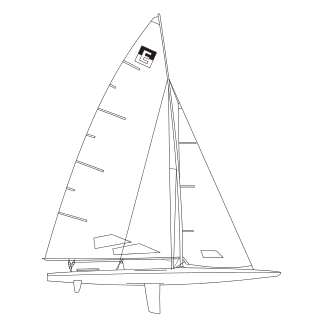
A sailboat or sailing boat is a boat propelled partly or entirely by sails and is smaller than a sailing ship. Distinctions in what constitutes a sailing boat and ship vary by region and maritime culture.

Dinghy sailing is the activity of sailing small boats by using five essential controls:
The Mirror is a popular sailing dinghy with more than 70,000 built.

A Bermuda rig, Bermudian rig, or Marconi rig is a configuration of mast and rigging for a type of sailboat and is the typical configuration for most modern sailboats. This configuration was developed in Bermuda in the 1600s; the term Marconi, a reference to the inventor of the radio, Guglielmo Marconi, became associated with this configuration in the early 1900s because the wires that stabilize the mast of a Bermuda rig reminded observers of the wires on early radio masts.

The Cadet is a class of sailing dinghy designed to be sailed by two children up to the age of 17. It is a one-design class, originally designed by Jack Holt in 1947. Cadets are sailed worldwide in more than 40 countries.

The Hobie Cat is a small sailing catamaran manufactured by the Hobie Cat Company. Hobie's line of products includes surfboards, sailboats, kayaks, stand-up paddle boards, and pedalboards, although the Hobie Cat Company is known worldwide for its catamarans. Hobie also designed a successful monohull, the Hobie 33.

The Laser 2 is a double-handed version of the popular Laser one-design class of small sailing dinghy. It is a quick, planing dinghy that differs from the Laser in that it has a jib, symmetric spinnaker and a single trapeze for the crew in the racing "Regatta" version. It was designed by New Zealander Frank Bethwaite and was first launched as a product in Australia then North America in 1979 and in Europe in 1980.

The Wanderer is a 14-foot Fibreglass hull Bermuda rigged sailing dinghy designed by Ian Proctor. One of the main objectives of the design was to produce a robust safe and versatile dinghy that could be used for knockabout day sailing and cruising as well as racing, but was light enough to be handled ashore.

The Tasar is a 14.83-foot (4.52 m) fiberglass 2 person sailing dinghy with a mainsail and jib. Designed by Frank Bethwaite of Sydney in 1975, the boat was technologically advanced for its time and continues to evolve. Aimed at a husband-and-wife or parent-and-child crew hence no spinnaker, it is designed for a combined crew weight of around 140 kg. The hull weighs 68 kg, and is of sandwich foam construction. The hull has a fine angle at the bow to reduce wave impact drag with unusually clean and sharp chines aft to ensure very free planing and outstanding stability. The foam cored hull is stiff and light and the advanced hull shape, together with an innovative rig which combines a rotating mast with a fully battened main sail, allows the Tasar to plane upwind with the crew normally hiked. The wide beam and a cockpit designed for comfortable hiking make the Tasar easy, fun and very exciting to sail in winds up to 25 knots (46 km/h).

A fractional rig on a sailing vessel consists of a foresail, such as a jib or genoa sail, that does not reach all the way to the top of the mast.

The Laser Stratos is an all-round cruising and racing boat designed by Phil Morrison and built by Laser Performance, the same company as the famous Laser Standard dinghy. It is built from fibre-glass and foam sandwich. The Laser Stratos comes in two forms, one with a keel and one with a centreboard. The centreboard version is red and the keel version is blue. The Stratos is quite spacious and most of the rigging is kept out of the way. The boat can optionally be fitted with trapeze lines and an engine bracket for carrying an outboard engine.

The E Scow is an American sailing dinghy that was designed by Arnold Meyer Sr as a one-design racer and first built in 1924.
A mast-aft rig is a sailboat sail-plan that uses a single mast set in the aft half of the hull. The mast supports fore-sails that may consist of a single jib, multiple staysails, or a crab claw sail. The mainsail is either small or completely absent. Mast-aft rigs are uncommon, but are found on a few custom, and production sailboats.

The Adventuress sailing dinghy class was designed by Ian Proctor and built by Anglo Marine of Essex. It is no longer in production.
The Pacer class of sailing dinghy, formerly known as the Puffin Pacer, was designed in the United Kingdom by Jack Holt. It was commissioned by Puffin Paints and Glues to be designed as sailing dinghy for use by families, so needing to be larger than their earlier Puffin dinghy. It has since become a popular learning and racing dinghy in Australia, Canada, the Netherlands, India and the UK. The name was changed in the UK early 1970s, although Australia continued to use the name until 1989, when they followed the UK in dropping the "puffin" and chose the wedge-tailed shearwater as the boat's symbol.

The 3000 is a racing sailing dinghy crewed by two persons with a trapeze for the crew. Launched in 1996 as the Laser 3000, the 3000 was developed from the Laser 2, using the original Frank Bethwaite-designed planing hull combined with a new designed self-draining deck by Derek Clark. Clark also re-designed the rig, using spars and sails from premium proprietary sources and replacing the symmetric spinnaker of the Laser 2 by a larger asymmetric spinnaker (gennaker). The gennaker is chute-launched and retrieved using a single halyard line, and is set on a retractable bowsprit. Helm balance and handling were improved using a shorter-footed mainsail with two full-width battens giving a larger roach. A mast with conventional spreaders replaced the now-unusual diamond arrangement of the Laser 2.
The Pegasus is a powerful and fast two person racing and cruising dinghy designed by Uffa Fox in 1958. It was notable for being a boat capable of being built at home using marine ply but still with an efficient and aesthetically pleasing round bilged hull form.
The Dabchick is a South African youth sailing dinghy that is raced two up or single-handed. A Bermuda rigged boat, it has a mainsail and jib. Its hull is very shallow and its skipper sits on its flat deck. This hard chined scow was designed by Jack Köper in 1955. Since they were published in 1956, nearly 3,500 plans have been issued to builders, and over 4,000 boats have been built. It is usually sailed by young crew with teenager skipper instead of the Optimist, before moving into higher performance classes.
ISO is an International Sailing Federation (ISAF) class of two-person sailing dinghy with a single trapeze and an asymmetric spinnaker. The ISO was designed in 1993 by Ian Howlett and John Caig and manufactured by Reg White Limited of Brightlingsea as part of the "White Formula" range of boats originally marketed by Topper International Ltd and since 2013 by Vantage Sailing Ltd. The boat has a fully battened mainsail, jib and an asymmetric spinnaker.

The Wētā 4.4 Trimaran is a 4.4 metre sailing dinghy conceived and developed in New Zealand from 2001-2006 by Roger and Chris Kitchen and others with original drawings by TC Design's Tim Clissold.
















